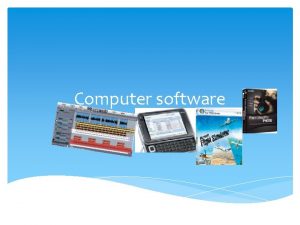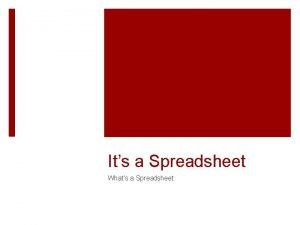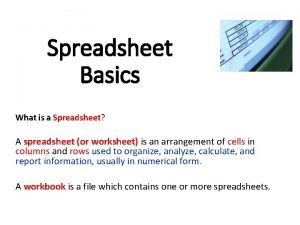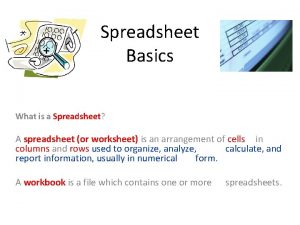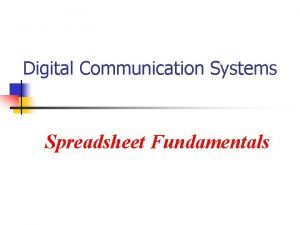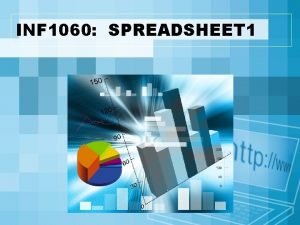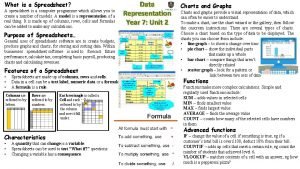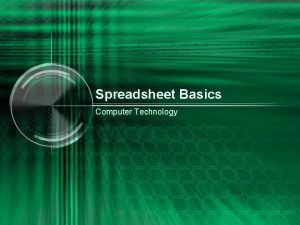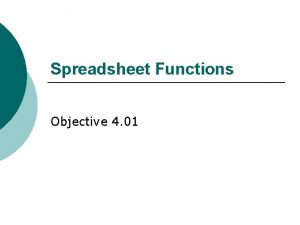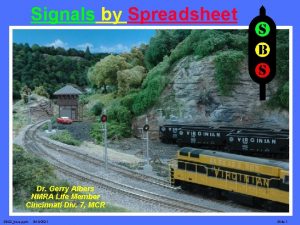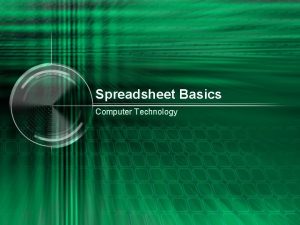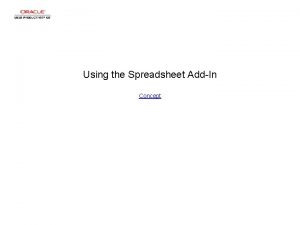lesson 14 Spreadsheet Software This lesson includes the















- Slides: 15

lesson 14 Spreadsheet Software

This lesson includes the following sections: • Spreadsheet Programs and Their Uses • The Spreadsheet's Interface • Entering Data in a Worksheet • Editing and Formatting a Worksheet • Adding Charts • Analyzing Data in a Spreadsheet

Spreadsheet Programs and Their Uses • Spreadsheets provide tools for working with numerical data. • You can use a spreadsheet program to create budgets, balance sheets, and other types of number- based documents. • You can display your information in a traditional row-and-column format, or in a chart.

Report using color and graphics Classic row and column format

The Spreadsheet's Interface • In a spreadsheet program, you work in a document called a worksheet. You can collect multiple worksheets into a file called a workbook. • Most Windows-based word spreadsheets offer a similar set of tools, including a formula bar, where you can enter and edit data. • Data is displayed in cells. A cell is the intersection of a row and column. • Each cell has a cell address – the combination of the cell's column letter and row number.

Cell Tool bars Menu bar Formula bar Row Column Status bar Scroll boxes

Entering Data in a Worksheet - Types of Data You enter four types of data in a worksheet's cells: • Labels--text or numbers not used in calculations. • Values--numbers that can be used in calculations. • Dates--a necessary part of most worksheets. • Formulas--commands to perform calculations based on numbers or formulas.

Entering Data in a Worksheet - Formulas and Functions • If a formula uses a value in another cell, the formula contains a cell reference, or the address of the referred cell. • Formulas can refer to entire ranges (or blocks) of contiguous cells as well as individual cells. • A function is a predefined formula, which the spreadsheet provides to perform a specific type of calculation. You provide arguments that tell the function what data to use.

Editing and Formatting a Worksheet • Spreadsheets provide many of the same editing and formatting tools found in word processors. • You can change, copy, move, and delete the data in any cell.

Relative and Absolute Cell References • If a formula uses a relative cell reference, it automatically dates if (copied or moved), to a different place. • An absolute cell reference always refers to the same cell even if the formula is moved to a different place.

Adding Charts • A chart is a graphical representation of the data in a worksheet. • Spreadsheets provide tools that make it easy to create a chart from worksheet data. • You can use many different types of charts, and apply many effects to a chart, to present your data in the most appropriate way.


Analyzing Data in a Spreadsheet Three commonly used data-analysis tools are: • What-if analysis, which lets you test scenarios to see how each affects the result. • Goal seeking, which finds values that make the result meet your specifications. • Sorting, which lets you arrange the worksheet's data in various ways.

lesson 14 review • Define and differentiate the terms worksheet and spreadsheet. • Identify four types of data that can be entered in a worksheet. • Explain how cell addresses are used in spreadsheet programs. • Explain what a formula is and how formulas can be used in spreadsheet programs. • List three types of analytical tools commonly found in spreadsheets.

Project due Dec. 14 • Use Microsoft Excel to import a student grade file and compute average for each student, home work, or examination. • Sort students by decreasing order of total score. • Type one page of Word document and import the grade histogram chart. • Demonstrate the difference of object linking and embedding with histogram chart.
 An example of number-crunching software includes
An example of number-crunching software includes Examples of word processor
Examples of word processor Hát kết hợp bộ gõ cơ thể
Hát kết hợp bộ gõ cơ thể Frameset trong html5
Frameset trong html5 Bổ thể
Bổ thể Tỉ lệ cơ thể trẻ em
Tỉ lệ cơ thể trẻ em Chó sói
Chó sói Chụp phim tư thế worms-breton
Chụp phim tư thế worms-breton Chúa yêu trần thế
Chúa yêu trần thế Các môn thể thao bắt đầu bằng tiếng bóng
Các môn thể thao bắt đầu bằng tiếng bóng Thế nào là hệ số cao nhất
Thế nào là hệ số cao nhất Các châu lục và đại dương trên thế giới
Các châu lục và đại dương trên thế giới Cong thức tính động năng
Cong thức tính động năng Trời xanh đây là của chúng ta thể thơ
Trời xanh đây là của chúng ta thể thơ Cách giải mật thư tọa độ
Cách giải mật thư tọa độ 101012 bằng
101012 bằng

